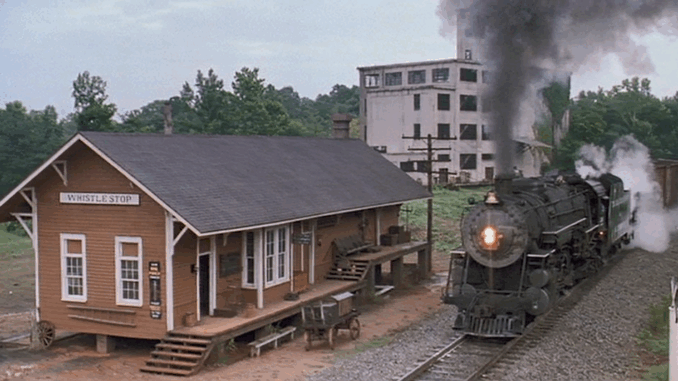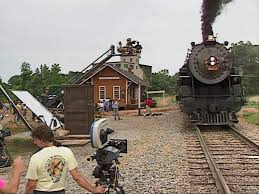
A Scene That Captures Idgie’s Spirit
In a film woven with memory, loss, and resilience, one of the most iconic and emotionally resonant scenes in Fried Green Tomatoes unfolds not in a courtroom or a kitchen—but beside a roaring river, high above the ground on a steel bridge. This is the scene where young Idgie Threadgoode, wild and untamed, performs an act so dangerous yet exhilarating that it defines her entire character: she walks out onto the train tracks as a locomotive approaches—and throws a bottle onto the tracks just before the train crushes it.
This is more than just childhood rebellion. It is the moment we meet the real Idgie.
Setting the Stage: Grief, Identity, and Escape
The scene comes early in the film, shortly after the sudden death of Idgie’s beloved brother Buddy, played by Chris O’Donnell. His loss fractures the family—and sends Idgie spiraling into a period of grief and emotional detachment. She retreats into the wild, into the woods and the rivers, as if the rules of society no longer apply to her.
When Ruth visits the Threadgoode family years later, she’s encouraged to spend time with the now feral, defiant Idgie. What Ruth witnesses is not just a stubborn girl, but someone searching for herself outside the confines of tradition and grief.
The Train Bridge: A Symbol of Defiance and Freedom
As Ruth and Idgie walk toward the bridge, the atmosphere changes. The steel tracks stretch ahead like a challenge. Idgie runs ahead, bottle in hand, and stands her ground on the bridge—daring the train to come. Ruth panics, urging her to move. The audience holds its breath.
Idgie places the bottle in the center of the tracks. Then, in one heart-stopping moment, she steps aside just in time as the train barrels past—shattering the bottle in an explosion of glass and thunder.
What Ruth sees in that moment isn’t just recklessness. It’s someone deeply alive, refusing to be boxed in by sorrow or expectation.
“You’re Just a Bee Charmer, Idgie Threadgoode”

This scene marks the real beginning of Ruth and Idgie’s bond. Later that day, Idgie shows Ruth how she sticks her bare hand into a wild beehive to retrieve honey, seemingly immune to stings. Ruth watches in awe and whispers a line that fans of the film never forget:
“You’re just a bee charmer, Idgie Threadgoode.”
It’s a moment of recognition—of affection. It’s the first time someone sees Idgie not as a lost girl, but as someone magical, strong, and whole in her own unique way.
A Coming-of-Age Scene Unlike Any Other
The train scene, paired with the bee charmer moment, functions as Idgie’s emotional rebirth. It doesn’t conform to traditional “girlhood” or coming-of-age tropes. There are no dresses, no dances, no romance in the air. Instead, there’s danger, dirt, and wildness—and through that, a sense of identity and power.
Idgie isn’t trying to fit in. She’s crafting her own world, one where she can survive the trauma of loss and forge connections on her own terms. It’s this spirit that later enables her to stand by Ruth through domestic abuse, to raise Ruth’s son, and to live openly and defiantly in a town that only half accepts her.
Symbolism on the Tracks
The train itself is more than just a vehicle. It’s a metaphor for society, tradition, and the forward march of time. By confronting it head-on—by placing something fragile (a glass bottle) on the tracks—Idgie symbolically places herself in the path of everything trying to crush her. And yet, she survives. The bottle shatters, but Idgie lives. And through that, the audience understands: she is someone who can face down the impossible and keep standing.
Ruth’s Awakening Begins
The impact on Ruth is just as important. At first, she is horrified—shocked by Idgie’s wildness. But later, that same courage draws her in. It plants a seed in Ruth: perhaps there is another way to live. A freer way. A way outside the abusive, patriarchal expectations she’s known. It’s this day, and this daring act on the bridge, that begins to change Ruth forever.
Why This Scene Endures
In a movie filled with emotional gut-punches and tender friendships, the train bridge scene remains unforgettable because it’s so raw and physical. It doesn’t rely on dialogue—it uses action, silence, and symbolism to show us a girl at war with the world, and with herself.
And it introduces a love story—subtle, unspoken, but powerful. A love story that begins with fear, transforms into wonder, and becomes the backbone of the film’s heart.
Final Thoughts: Where Courage Meets Grief
The railroad tracks in Fried Green Tomatoes represent more than just a crossing—they represent the point where a girl chooses her own path. Where she risks everything to feel something again. And where she first becomes the legend that Ruth—and the audience—will never forget.
Because that day on the bridge wasn’t just about the bottle. It was about breaking through the weight of grief, one heartbeat ahead of the train.
